Physical Address
304 North Cardinal St.
Dorchester Center, MA 02124
Due to the wide array of available accepted therapies, as well as the increasing number of experimental treatments undergoing clinical trials for the management of glial neoplasms, the task of the radiologist to make appropriate interpretations can seem daunting. In this chapter, we review the clinical, pathologic, and imaging findings associated with these therapies and offer recommendations on the imaging approach in these scenarios.
The ideal surgical treatment for glial tumors is maximal total resection with minimal neurologic side effects. However, this objective is achieved only in a relative minority of cases, due to the deep location of some tumors or their close proximity to eloquent cortical areas and other vital structures. Chemoradiation is a well-established step in the treatment of high-grade tumors, with partial brain fractionated radiotherapy combined with temozolomide (TMZ) being the accepted standard treatment after maximal cytoreductive surgery. Antiangiogenic treatment, particularly bevacizumab, is usually reserved for tumor recurrence after chemoradiation. Newer therapies include immunotherapy and checkpoint inhibitors, but their effectiveness has not been consistently proven in clinical trials.
Leakage of contrast along the surgical margins can confuse the radiologic assessment of residual tumor, particularly after a repeat dose of gadolinium contrast agents or when there is significant delay after contrast administration ( Fig. 15.1 ). Hyperacute hemorrhage can be difficult to identify due to similarities in its signal characteristics to cerebrospinal fluid (CSF) ( Fig. 15.2 ). Therefore a high index of suspicion for hyperacute hemorrhage should be present when large unexplained areas of fluid signal are seen within the surgical cavity or surrounding brain parenchyma.


The aims of imaging in the postoperative period include detection of residual tumor and assessment of postoperative complications. One potential imaging pitfall is the presence of hemorrhage. In the setting of subacute hemorrhage shortly after surgery, the presence of intracellular methemoglobin demonstrates T1 shortening which may be mistaken for enhancement on gadolinium-enhanced T1-weighted images. The acquisition of a precontrast T1-weighted sequence is helpful for clarifying this because residual enhancing tumor would show relative T1 shortening between the precontrast and postcontrast images ( Fig. 15.3 ).

A variety of nontumoral processes can cause apparent enhancement, including postsurgical changes. For example, postoperative ischemic changes presenting with diffusion restriction along the margins of the surgical site may have associated enhancement in the subacute period. As such, it is generally suggested that contrast-enhanced magnetic resonance imaging (MRI) should be performed within 48 hours after surgery.
One potential pitfall is patients who have received electrocoagulation at the surgical site. Solid parenchymal enhancement that can be indistinguishable from residual tumor may appear even on intraoperative imaging.
Laser-induced thermotherapy (LITT) allows for both biopsy and laser-guided ablation of lesions. A laser probe is placed into the core of the lesion and induces thermal coagulation, creating a region of coagulative necrosis. The typical early postsurgical change after this procedure is characterized by five concentric areas, including a peripheral rim of abnormal enhancement and perilesional edema ( Fig. 15.4 ).

Local delivery of chemotherapeutic agents and radiation therapy (RT) are also options in the treatment of glial tumors. Examples of these therapeutic options include Gliasite for localized RT ( 125 I) into the surgical site and Gliadel wafers for intracavitary chemotherapy. A significant proportion of cases treated with Gliadel wafers can experience transient worsening of imaging findings during the first 4 weeks after placement ( Figs. 15.5 and 15.6 ).


Packing or hemostatic material (e.g., Gelfoam, Surgicel) left inside a surgical cavity during the resection of a glial tumor can trigger a foreign body reaction in some patients. The resulting pseudotumoral lesion is often called gossypiboma (when triggered by cotton material), textiloma, and gauzoma, among other terms. Importantly, this reaction can exhibit imaging features that overlap with tumor recurrence, such as contrast enhancement. However, in contrast to high-grade gliomas, follow-up imaging should demonstrate relatively stable mass effect and adjacent T2 prolongation except in the setting of complications (i.e., secondary infections) ( Fig. 15.7 ).

Pseudoprogression is the apparent worsening of abnormal enhancement, T2-hyperintense areas, or local mass effect that is often seen in patients with glial tumors after radiation treatment. This phenomenon usually occurs weeks to 3 months after treatment, whereas radiation necrosis often occurs 18 to 24 months to years afterward ( Table 15.1 , Fig. 15.8 ).
| Time Course | Imaging Findings | Outcomes | |
|---|---|---|---|
| True progression | Anytime |
|
|
| Pseudoprogression (radiation therapy) | ≤3 months |
|
|
| Radiation necrosis | ≥6 months |
|
|
| Pseudoresponse (antiangiogenic therapy, i.e., bevacizumab) | Weeks to months |
|
|
| Pseudoprogression (immunotherapy, i.e., checkpoint inhibitors) | ≤6 months |
|
|

Although pseudoprogression can occur after isolated RT, it has also been described after combined RT and TMZ. There is also an association with methylguanine methyltransferase (MGMT) gene promoter methylation. Although the incidence is thought to be between 20% and 25% among all patients, those with MGMT gene promoter methylation have a significantly higher incidence, at approximately 35% to 40%. Along these lines, MGMT methylation predicts pseudoprogression in approximately 90% of cases.
An important clinical implication is that the presence of radiologic pseudoprogression is associated with improved 1- and 2-year progression-free survival. Conversely, patients with MGMT-unmethylated tumors have relatively higher rates of progressive disease.
Become a Clinical Tree membership for Full access and enjoy Unlimited articles
If you are a member. Log in here